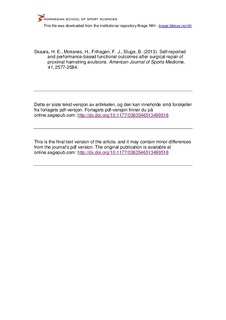| dc.contributor.author | Skaara, Heléne Engberg | |
| dc.contributor.author | Moksnes, Håvard | |
| dc.contributor.author | Frihagen, Frede | |
| dc.contributor.author | Stuge, Britt | |
| dc.date.accessioned | 2014-11-24T13:33:42Z | |
| dc.date.available | 2014-11-24T13:33:42Z | |
| dc.date.issued | 2013-08-29 | |
| dc.identifier.citation | American Journal of Sports Medicine. 2013, 41, 2577-2584 | nb_NO |
| dc.identifier.uri | http://hdl.handle.net/11250/226380 | |
| dc.description | I Brage finner du siste tekst-versjon av artikkelen, og den kan inneholde ubetydelige forskjeller fra forlagets pdf-versjon. Forlagets pdf-versjon finner du på www.sage.com: http://dx.doi.org/10.1177/0363546513499518 / In Brage you'll find the final text version of the article, and it may contain insignificant differences from the journal's pdf version. The original publication is available at www.sage.com: http://dx.doi.org/10.1177/0363546513499518 | nb_NO |
| dc.description.abstract | Background: Because a proximal hamstring avulsion results in residual loss of function, surgical repair is recommended. Few studies have investigated postoperative function with validated outcomes.
Purpose: To examine lower extremity function after surgical repair of proximal hamstring avulsions using validated self-reported and performance-based functional outcomes.
Study Design: Case series; Level of evidence, 4.
Methods: Operative records from 2006 to 2010 were retrospectively reviewed in 3 hospitals. A total of 39 patients who had undergone surgical repair of a proximal hamstring avulsion were identified, and 36 met the inclusion criteria. Thirty-one patients completed questionnaires with demographic background data and quality of life–related questions: the Lower Extremity Functional Scale (LEFS) and the Proximal Hamstring Injury Questionnaire (PHIQ). Thirty patients were evaluated using a Biodex dynamometer for isokinetic quadriceps and hamstring strength measurements at a velocity of 60 deg/s, and 27 patients performed 4 single-legged hop tests.
Results: Twenty-eight repairs were acute (<4 weeks), and 3 were chronic. There were complete ruptures of all 3 tendons in 17 (55%) cases. The mean follow-up was 30 months. Most patients experienced little or no pain or limitations during activities of daily living. The mean LEFS score was 89%, and 29 (94%) of the 31 patients were satisfied with the result after surgery. Eighteen (58%) of the 31 patients had returned to their preinjury activity level. Significant differences in the mean hamstring strength (peak torque) (P < .001) and single-legged hop test (P = .01) between the uninvolved and involved leg were found. Twenty-two (71%) of the 31 patients did not fully trust their operated leg during physical activities and feared sustaining a hamstring injury. Return to activity significantly correlated with the single-legged hop test, the LEFS score, and the questions regarding trust and fear.
Conclusion: In this study, using both validated self-reported and performance-based outcome measures after surgical repair of proximal hamstring avulsions, minor pain and limitations to activities of daily living were seen. Isokinetic hamstring strength in the operated leg was significantly lower compared with the nonoperated leg, and a majority of the patients did not trust the operated leg completely during physical activity. | nb_NO |
| dc.language.iso | eng | nb_NO |
| dc.publisher | SAGE | nb_NO |
| dc.subject | hamstring injury | nb_NO |
| dc.subject | complete tear | nb_NO |
| dc.subject | avulsion | nb_NO |
| dc.subject | surgical repair | nb_NO |
| dc.subject | function | nb_NO |
| dc.title | Self-reported and performance-based functional outcomes after surgical repair of proximal hamstring avulsions | nb_NO |
| dc.type | Journal article | nb_NO |
| dc.type | Peer reviewed | nb_NO |
| dc.subject.nsi | VDP::Social science: 200::Social science in sports: 330 | nb_NO |
| dc.subject.nsi | VDP::Medical disciplines: 700::Clinical medical disciplines: 750 | nb_NO |
| dc.subject.nsi | VDP::Medical disciplines: 700::Sports medicine: 850 | nb_NO |
| dc.source.journal | American Journal of Sports Medicine | nb_NO |
| dc.description.localcode | Seksjon for idrettsmedisinske fag / Department of Sports Medicine | nb_NO |
